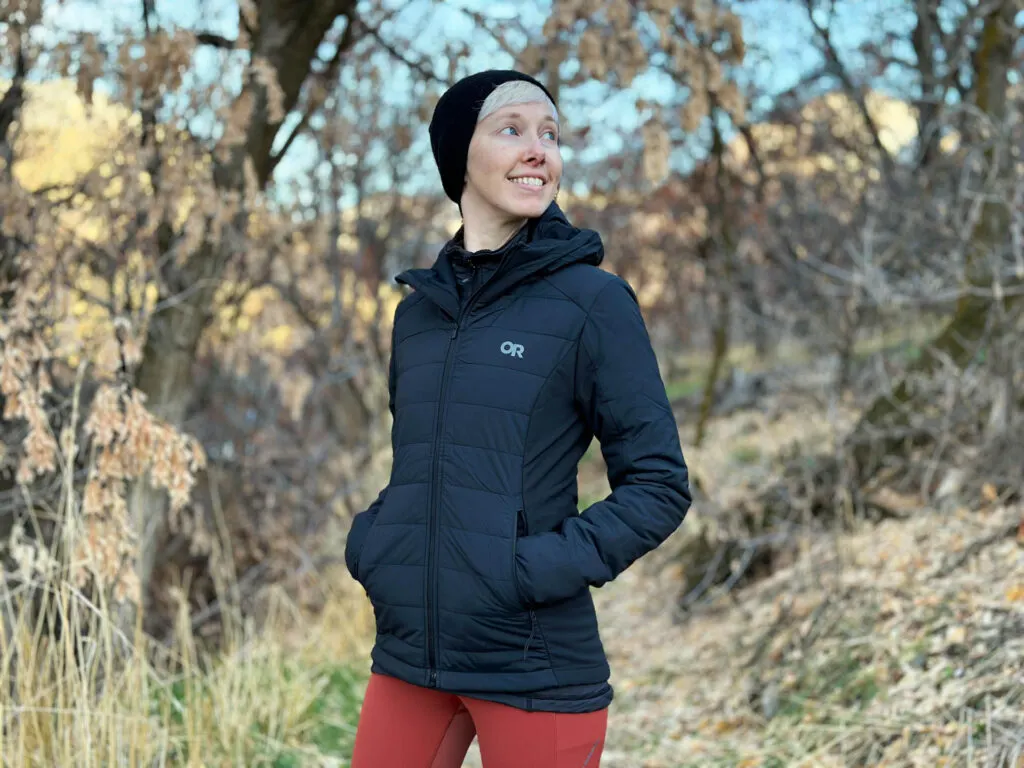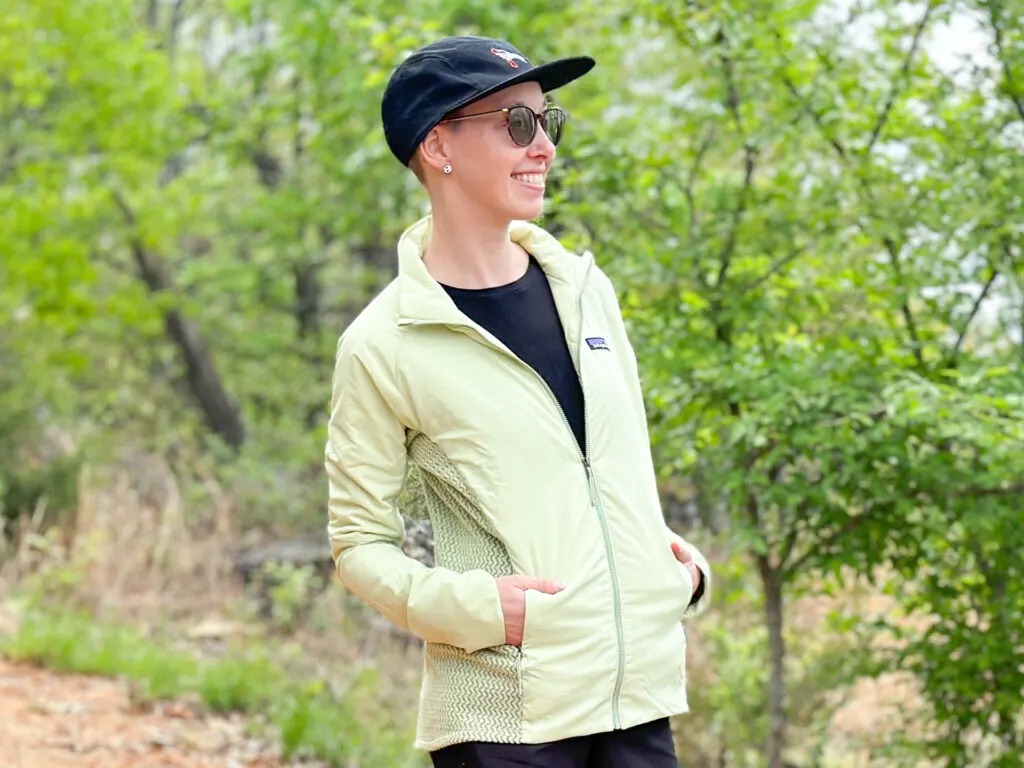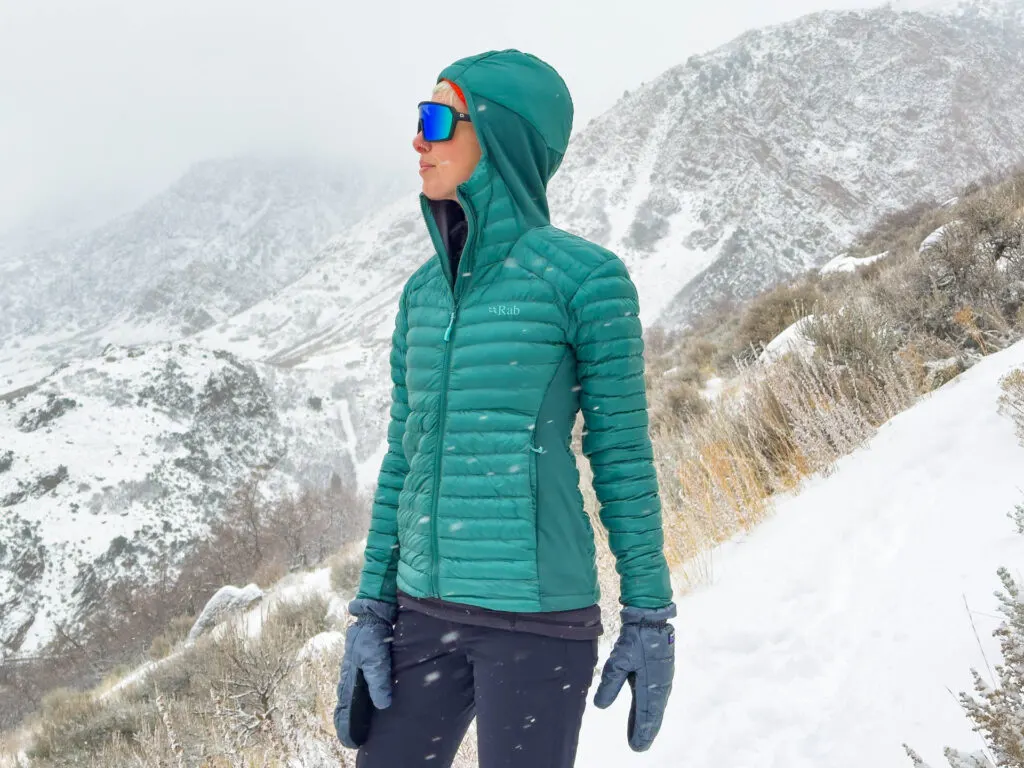REI Anniversary Sale May 16-26 - Up to 30% off plus 20% off member deals!
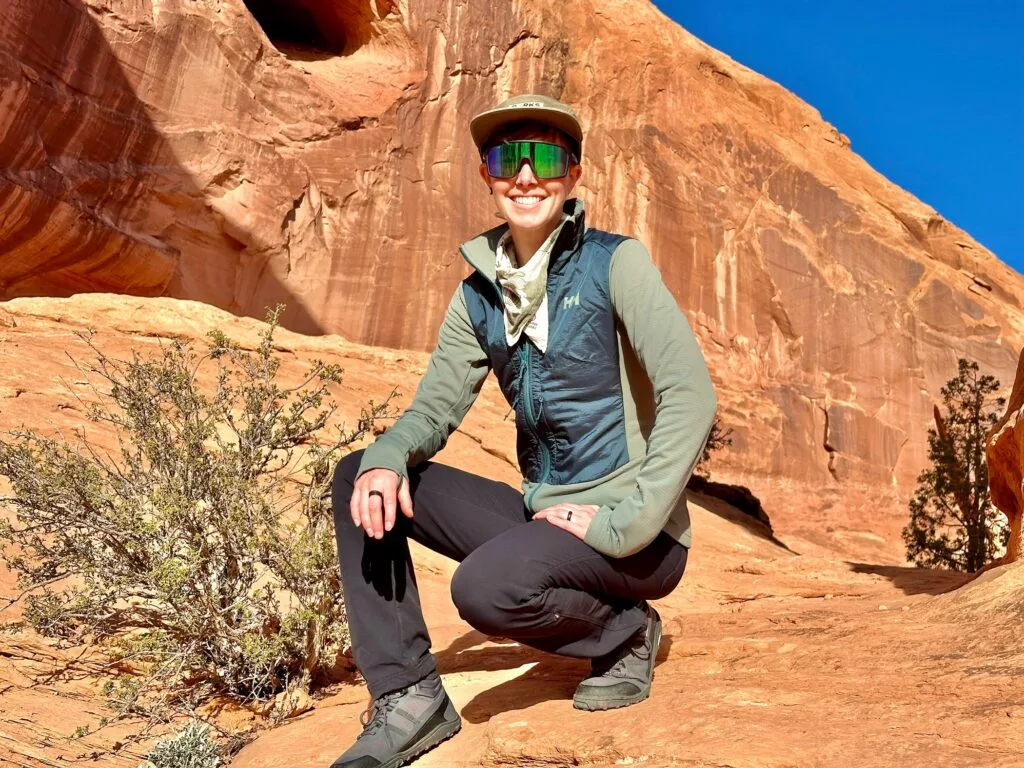
Hybrid jackets. They’re a beautiful thing. You’ve got nice cozy insulation in the front, sometimes the back, exactly where you need it to keep you warm plus plenty of stretch on the sides or under the arms to aid in breathability and flexibility. It’s the best of both worlds: warmth and freedom of motion.
But why choose a hybrid jacket instead of a conventional insulated jacket? Where do hybrid jackets excel? Short answer: active pursuits. Long answer: Well, that really depends on the jacket, doesn’t it? But in general, hybrid jackets tend to be pretty dang versatile. For starters, those stretchy panels mean they make excellent midlayers during active pursuits (read more about the importance of layering in this post)
Why? Regular insulated jackets don’t tend to have any stretch, so when you’re wearing between 3-6 layers in the winter, all of it can feel incredibly restrictive and you tend to lose a fair amount of freedom of motion, which is no bueno when you’re climbing or skiing or backpacking. Heck, even hiking.
But hybrid jackets are also great as an external layer during cool weather or really high-output activities like trail running or uphill skinning or strenuous hiking in cold weather. They tend to breathe well, let you move however you need to, and are less bulky than more traditional insulators.
What they’re not as well suited for are wet-weather activities since they don’t tend to be as water resistant, or more stationary pursuits like sitting around the campground since they’re not insulated all around your arms and midsection. So check out our list of sustainable insulated jackets in this post.
Think you might benefit from a hybrid jacket? We reviewed 4 more sustainable jackets that are not only vegan, but also PFC-free (read more about PFC’s here). Huzzah!
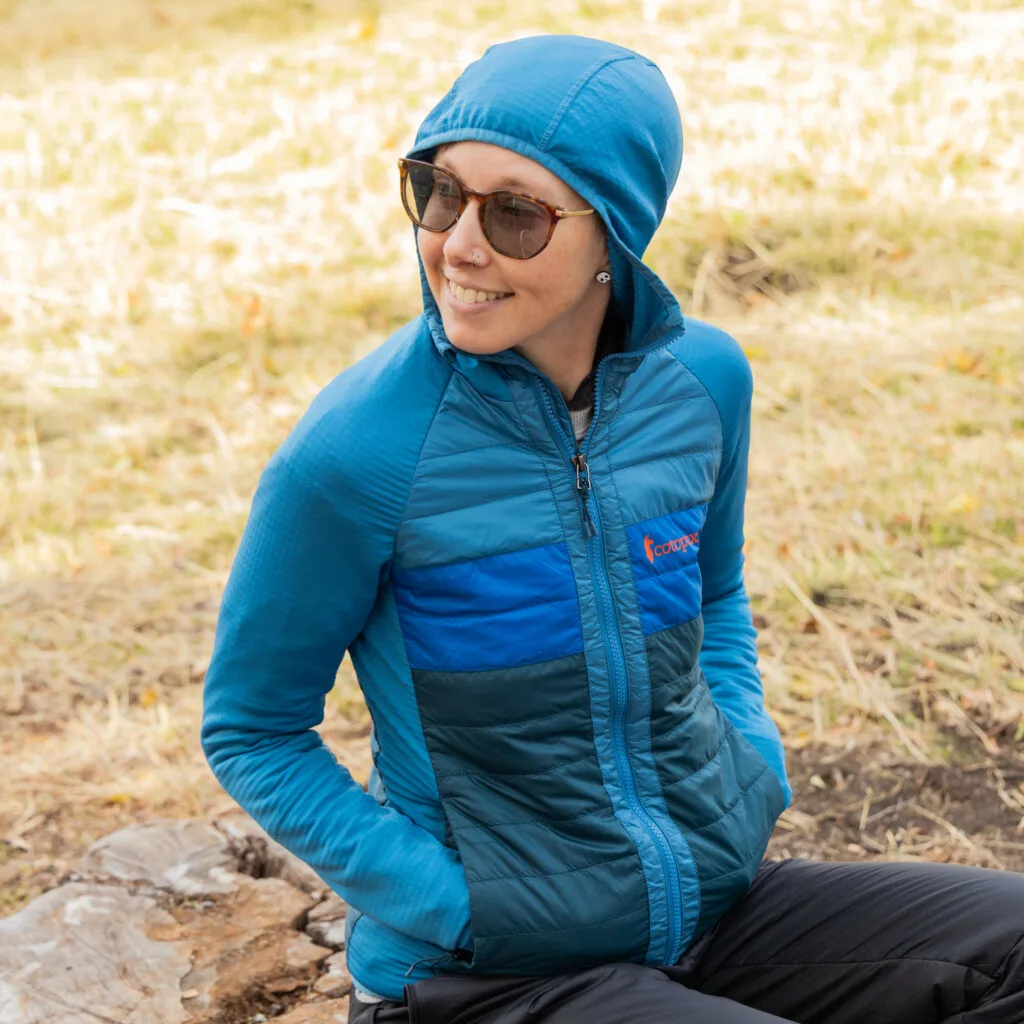
Cotopaxi Capa Hybrid Insulated Hooded Jacket
Looking to add some color to your layering system? Try the Cotopaxi Capa Hybrid Insulated Jacket on for size. It offers a happy medium between warmth and freedom of movement not always available in a hybrid layer. That’s thanks to lightly insulated front and back panels coupled with sleeves and side panels made of a stretchy grid fleece. Which means your front and back stay warm and more protected from the wind on active or stationary adventures while heat can escape from the sides when you’re working a bit harder, like during uphill hikes.
The jacket is available in a hooded and non-hooded version so you can pick your poison. The hood, by the way, is made of the stretch grid fleece, so it feels functional and fitted without being bulky or annoying. There are two zippered hand pockets on the outside and one interior zippered chest pocket, plus thumb holes.
And while we find some Cotopaxi apparel runs a bit on the large side, the Capa Hybrid jackets seem to be just right. The XS fit perfectly with a fitted layer underneath while still layering effortlessly under a shell or larger puffy jacket. Basically, it’s a comfy, lightweight midlayer for chilly days that doesn’t restrict movement in the least.
How It’s Sustainable: Made from a 100% recycled nylon shell and synthetic PrimaLoft Gold P.U.R.E. (Produced Using Reduced Emissions) Insulation. Also made with Bluesign approved fabric and PFAS-free.
Available Sizes & Colors: Comes in S to XXL for men and XXS to XXL for women, one of the brand’s offerings available in slightly extended sizing. Each comes in a handful of colors, though the men’s are mostly neutral. The hoodless version is available in fewer sizes.
Pros
- Lightweight
- Non-bulky midlayer
- Fitted
- Thumbholes
- Fun colors available
- Super stretchy
Cons
- Not as warm as other options on this list
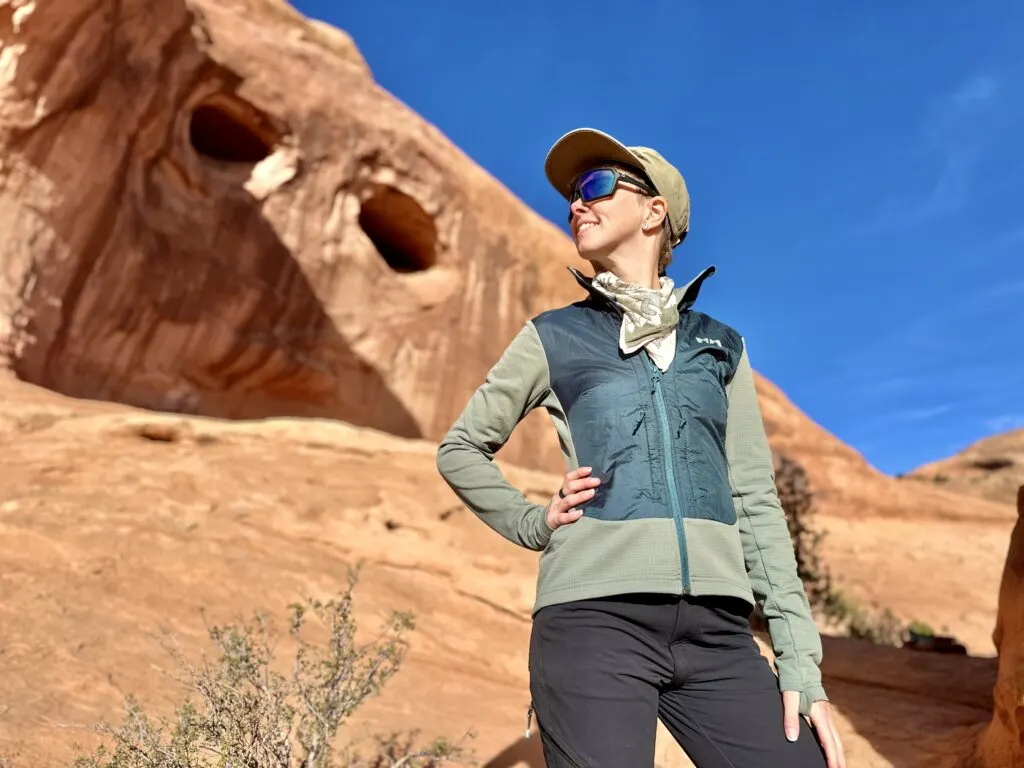
Helly Hansen Versatile Hybrid Fleece Jacket
This hybrid insulated jacket is one of the most unique options on this list. Designed specifically for active pursuits like trail running, cross country skiing, hiking, etc., it features a wind-resistant and lightly insulated front panel to keep your core warm, but the rest of the jacket is a soft and super stretchy micro-grid fleece that is lightly cozy, wicks sweat, and also allows your body to dump heat when you’re working hard.
There are interior drop pockets, a high color with a chin collar, and a nice drop hem on the women’s version so it’s long enough to stay put and keep things covered, but not so long that it gets in the way. An XS was fitted, but not so snug I couldn’t wear a fitted base layer underneath, and the sleeves were the perfect length when using the thumb holes. Plus the grid fabric is very stretchy and movement is never restricted. Honestly, it makes a pretty solid midlayer.
We weren’t sure we would love the exterior pockets on this one, though. Instead of traditional zippered hand pockets located by your hips, the pocket zippers are located near the center zip and are designed more as reach-in pockets. This isn’t so weird on the men’s jacket as they are placed on the chest, but the women’s pockets are located lower, near the bottom of the rib cage. That said, after limited testing, these pockets proved useful during active pursuits because items placed in them are easily accessible, they don’t get covered by backpack straps or hip belts, and if you’re wearing the Versatile Hybrid Fleece as a mid layer, you can actually access the pockets when unzipping your outer layer; you wouldn’t as easily be able to get into midlayer side seam pockets. So while they may be an adjustment, they do make logical sense, especially when considering it’s an active layer designed for use when you’ll probably be using your hands, anyway.
How It’s Sustainable: The shell is made of 94% recycled polyester and the whole jacket is a bluesign® product and PFAS-free.
Available Sizes & Colors: Comes in S to XXL for men and XS to XL for women. It comes in a limited selection of neutral-leaning colors.
Pros
- Cozy grid fleece on the interior
- Thumb holes
- Stretchy fleece hood
- Pockets accessible when wearing layers
- Windproof front panels
- Breathable back, sleeves and sides
- High collar
Cons
- Not many colors available
- Non-traditional pocket placement
Outdoor Research Shadow Hoodie II
The warmest, most durable, windproof option on the list is the Outdoor Research Shadow Insulated Hoodie II. It’s both water and wind resistant, has thumb holes (love), a bungee on the hem and the back of the hood, plus the insulation is made of a combo of recycled polyester and partially bio-based Sorona fabric, and the sides are made of a stretchy material that’s super soft and warm and fleecy on the inside. So dang cozy.
This has become my go-to jacket for really chilly active pursuits. It’s one of the most insulated of the bunch–by which I mean it’s thicker and heavier–and is an excellent quality jacket. The outer materials feel more durable than delicate, so that’s a pro for folks who tend to ride their gear hard, plus it has all the features you look for in a layer of this caliber.
The bungee on the insulated hood really helps it conform to the size and shape of your head, and the thumbs loops are obviously a win, especially if you’ll be wearing int on it’s own like I did for cold-weather runs. The hand pockets and chin guard are lined with a soft material that’s a really nice touch, very warm and cozy, but the drop pockets on the inside are super long and narrow, to the point where all that’s gonna fit in there is a pair of liner gloves at most. At least on the extra small. I’m sure it’s a more useful size on larger jackets.
The Shadow Hoodie is nice and fitted. I love how snug it is while still leaving enough room for a fitted layer or two underneath. It’s a great option for extra chilly trail runs or sunny cross country ski days or cool mornings at the crag. Activities where you’ll be working hard, but still need a little extra protection from the elements.
I will say, though, that the sleeves are very long. You can just yank them up, of course, but if you have long arms, take note: this might be the jacket for you. The arms are also fairly roomy compared to the torso.
But I want to talk about this Sorona fabric for a sec. The material’s website is pretty cryptic and probably can’t be deciphered by anyone without a chemical engineering degree–I do not have a chemical engineering degree–but from what I could find, the fabric is only 37% bio- or plant-based. The rest of it is still synthetic.
It uses 30% less energy and creates 50% less greenhouse gas emissions than conventional nylon, but I did a little digging and it seems like recycled nylon leaves an even lighter footprint–around 50% less energy and 50% fewer greenhouse gasses–so…I’m not sure I’m sold on this material being an innovation worth celebrating.
Available Sizes & Colors: Comes in S to XXXL for men but only XS to XL for women. Feels like we’re missing some size inclusivity there. It comes in a handful of colors, too.
Pros
- Warm
- Wind- and water-resistent
- Fitted
- Adjustable hood and hem
- Thumbholes
- Durable material
Cons
- Very long sleeves
- The sustainability of the new Sorona fabric seems suspect
The Patagonia Nano-Air Light Hybrid Jacket
Materials-wise, The Patagonia Nano-Air Light Hybrid Jacket might be my favorite, mostly because the front and sleeve fabric is buttery soft (though won’t be quite as durable as some of these other options, I think). It’s also insulated for warmth while the entire back panel and underside of the arms is a super stretchy, soft and breathable fleece.
All of the jacket–except for a small percentage of the insulation–is made of completely recycled polyester and the shell has a PFC-free water repellent coating to help keep you dry in light rain.
I loved this one for uphill hiking and trail running. It fit seamlessly under a shell and over a synthetic tee. And while the insulation feels super lightweight and minimal, it actually kept me really warm on a trail run in thirty-five degree temps and blowing wind, even with as slow a runner as I am. I mean, I had it fully unzipped by mile 1.5. That’s how good of an insulator it is.
Is it the warmest on this list or the most windproof from all sides? Well, no, but if you’re looking for an excellent midlayer that feels like a sweater for really high-output pursuits, this may be the one for you. Bonus: it’s not hooded, which I like in a midlayer (though there is a hoody version).
And I never felt like my range of motion was inhibited. I mean, that fleece Air Wave material is impressively stretchy. The sleeves are a bit snug compared to the body of the jacket–at least in my opinion–but the whole thing is designed to be fitted, and the ample stretch offers plenty of wiggle room in the fit department.
I tested a size small, but an extra small would have been better for me, which is to say the jacket runs true to size, but size up if you plan to layer it over anything remotely bulky. A small left plenty of room when worn over a roomy grid fleece.
There aren’t a ton of additional features: just two hand pockets, no internal drop pockets or anything in the way of bungees, but I don’t have a problem with that.
Available Sizes & Colors: It’s available in several colors (though no longer this soft green) an in sizes XS to XXL in both women’s and men’s.
Pros
- Buttery fabric
- Tons of stretch
- Extremely breathable
- Super warm for its weight
- Comfortable
- No hood makes it great for layering
Cons
- Expensive
- Doesn’t feel as durable
- Not as many bells and whistles
Rab Cirrus Flex Insulated Hooded Jacket
So, spoilers, The Cirrus Flex might be my overall favorite jacket of the bunch. Mostly because it feels like wearing a cozy sweater. For real. But also because the proportions are just perfect. For me, at least. Obviously your experience may vary. But the sleeves are the perfect length, the body and sleeves were just the right amount of fitted, and frankly, it just cuts a flattering silhouette.
The side panels that extend down the arms offer the perfect amount of stretch and this thing didn’t feel restrictive at all under a shell or over a fitted base layer or two.
But maybe my favorite feature is the hood. Often, I don’t like hoods on mid layers because it’s easy when you’re layering to just get too many hoods piled up. But this hood is baller. It fits beautifully and stays put even without a bungee, AND has stretchy panels on the sides, which means not only can you pull it over your head with the jacket zipped all the way up, which you can’t do with most jackets, it also doesn’t restrict head movement. It just moves with you when you turn from left to right.
Plus it has nice tall zippered hand pockets so you can get into them even if you’re wearing a backpack with a hip belt or a harness, stash pockets on the inside, and a large section of soft fabric by your chin. It’s lightweight and the fabric is silky, and honestly, I would wear this around the house as a sweater in addition to a midlayer or active outer layer. And did I mention it can be packed into its own pocket?
The super silky down-like insulation is made of 100% recycled materials, as is the satiny outer and liner fabric–just not the fleece panels. Plus, it’s all PFC-free.
Available Sizes & Colors: This jacket comes in a ton of colors for women and men (Eucalyptus color pictured) and in XS to XXL for women and men.
Pros
- Fits like a glove
- Stretchy hood and panels
- Bungee in the hem
- Wears like a sweater
- Warm
- Soft to the touch
- Super flexible
Cons
- Not quite as durable as an outer layer (but we’re nit-picking, here…this is our fave of the bunch)
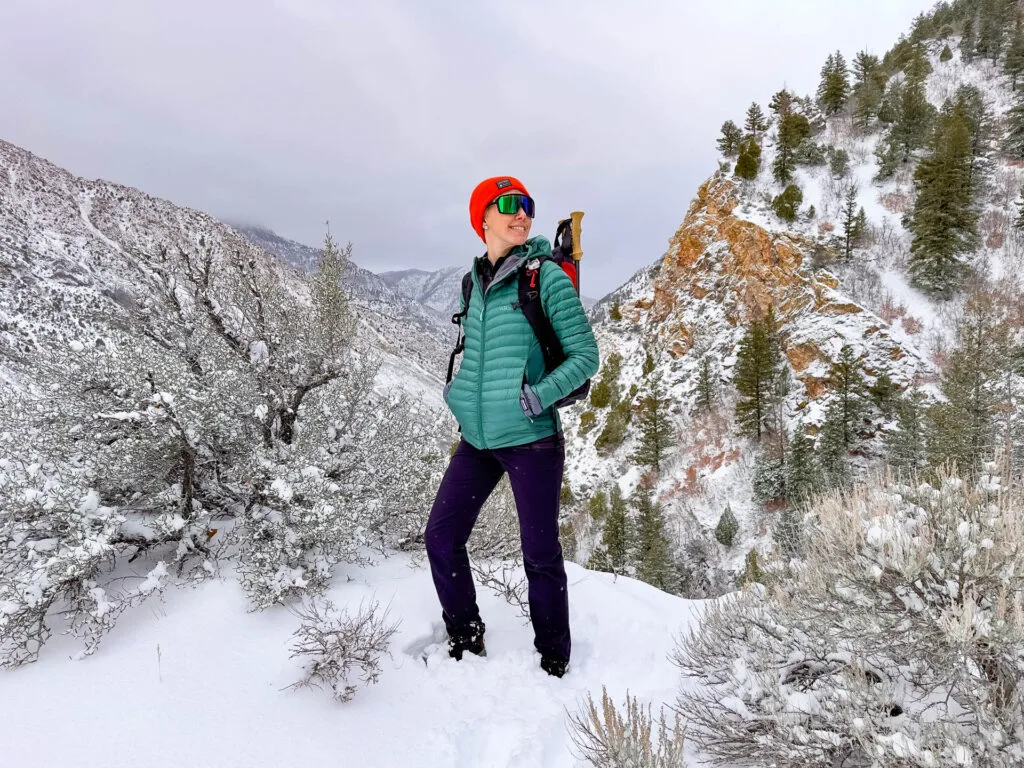
How to Pick the Right Size Jacket
Now, a note on sizing on all of these, especially if you’re ordering a women’s cut: they all run pretty true to size, but are designed to be worn over a fitted base layer or two. So if you think you’ll be layering these over bulkier items like a fleece sweater or something, size up.
Bottom Line
When it comes to updating your layers, remember, the truly sustainable choice is to repair and rewear the gear you already have before going out and buying something new. Or, try to find one of these jackets used (here are some of our favorite places to get used gear). Then take care of it, enjoy wearing the heck out of it for years to come, and get out there and wander on this season.

